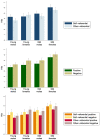Recall bias during adolescence: Gender differences and associations with depressive symptoms
- PMID: 33421856
- PMCID: PMC7615279
- DOI: 10.1016/j.jad.2020.12.133
Recall bias during adolescence: Gender differences and associations with depressive symptoms
Abstract
Background: There is a sharp increase in depression in females in mid-adolescence, but we do not understand why. Cognitive theories suggest that people with depression have negative biases in recalling self-referential information. We tested whether recall biases were more negative in girls in early and mid-adolescence and were associated with depressive symptoms.
Methods: 315 young and 263 mid-adolescents (11-12 and 13-15 years) completed a surprise test, assessing recall of social evaluation about the self (self-referential) or another person (other-referential). The short Mood and Feelings Questionnaire measured depressive symptoms. We tested the effects of condition (self-referential/other-referential), valence (positive/negative), gender, and age group on correct recall (hits) and associations with depressive symptoms.
Results: There was no evidence for gender or age differences in positive or negative self-referential recall. Self-referential positive hits were negatively associated with depressive symptoms (adjusted coefficient=-0.38, 95% CI=-0.69-0.08, p=0.01). Self-referential negative hits were positively associated with depressive symptoms (adjusted coefficient=0.45, 95% CI=0.15-0.75, p=0.003), and this association was stronger in females (adjusted interaction p=0.04).
Limitations: The reliability and validity of the recall task are unknown. We cannot provide evidence of a causal effect of recall on depressive symptoms in this cross-sectional study.
Conclusions: Adolescents who recalled more self-referential negative and fewer self-referential positive words had more severe depressive symptoms. Females did not demonstrate more recall biases, but the association between self-referential negative hits and depressive symptoms was stronger in females. Negative self-referential recall may be a risk factor for depressive symptoms and is a good candidate for longitudinal studies.
Keywords: Adolescence; Cognition; Depression; Gender difference; Memory; Recall bias.
Copyright © 2020. Published by Elsevier B.V.
Figures


Similar articles
-
Self-schemas and information processing biases as mechanisms underlying sexual orientation disparities in depressive symptoms: Results from a longitudinal, population-based study.J Psychopathol Clin Sci. 2023 Aug;132(6):681-693. doi: 10.1037/abn0000823. Epub 2023 Jun 15. J Psychopathol Clin Sci. 2023. PMID: 37326561 Free PMC article.
-
The combined influence of cognitions in adolescent depression: Biases of interpretation, self-evaluation, and memory.Br J Clin Psychol. 2018 Nov;57(4):420-435. doi: 10.1111/bjc.12184. Epub 2018 May 25. Br J Clin Psychol. 2018. PMID: 29799126 Free PMC article.
-
Depression risk and electrocortical reactivity during self-referential emotional processing in 8 to 14 year-old girls.J Abnorm Psychol. 2016 Jul;125(5):607-19. doi: 10.1037/abn0000173. Epub 2016 May 12. J Abnorm Psychol. 2016. PMID: 27175985 Free PMC article.
-
Electrocortical Reactivity During Self-Referential Processing Predicts the Development of Depression Across Adolescence.Biol Psychiatry Cogn Neurosci Neuroimaging. 2024 Sep;9(9):958-965. doi: 10.1016/j.bpsc.2024.04.016. Epub 2024 May 4. Biol Psychiatry Cogn Neurosci Neuroimaging. 2024. PMID: 38710386
-
Self-referential schemas and attentional bias predict severity and naturalistic course of depression symptoms.Cogn Emot. 2017 Jun;31(4):632-644. doi: 10.1080/02699931.2016.1146123. Epub 2016 Feb 22. Cogn Emot. 2017. PMID: 26901406
Cited by
-
Specificity of Episodic Future Thinking in Adolescents: Comparing Childhood Maltreatment, Autism Spectrum, and Typical Development.Res Child Adolesc Psychopathol. 2024 Nov;52(11):1781-1795. doi: 10.1007/s10802-024-01232-7. Epub 2024 Aug 21. Res Child Adolesc Psychopathol. 2024. PMID: 39167319 Free PMC article.
-
Social feedback biases emerge during recall but not prediction and shift across the development of social anxiety.Proc Natl Acad Sci U S A. 2023 Dec 26;120(52):e2308593120. doi: 10.1073/pnas.2308593120. Epub 2023 Dec 20. Proc Natl Acad Sci U S A. 2023. PMID: 38117853 Free PMC article.
-
Assessing childhood and adolescent development of self-concepts via a self-referent encoding task.Psychol Assess. 2025 Mar;37(3):100-113. doi: 10.1037/pas0001363. Psychol Assess. 2025. PMID: 39946629
-
Binge drinking indirectly predicts a negative emotional memory bias through coping motivations and depressive symptoms: The role of sex/gender.Front Psychol. 2022 Nov 21;13:998364. doi: 10.3389/fpsyg.2022.998364. eCollection 2022. Front Psychol. 2022. PMID: 36483715 Free PMC article.
-
Age-related changes in the impact of valence on self-referential processing in female adolescents and young adults.Cogn Dev. 2022 Jan-Mar;61:None. doi: 10.1016/j.cogdev.2021.101128. Cogn Dev. 2022. PMID: 35125644 Free PMC article.
References
-
- Alloy LB, Black SK, Young ME, Goldstein KE, Shapero BG, Stange JP, Boccia AS, Matt LM, Boland EM, Moore LC, Abramson LY. Cognitive vulnerabilities and depression versus other psychopathology symptoms and diagnoses in early adolescence. J Clin Child Adolesc Psychol. 2012;41:539–560. doi: 10.1080/15374416.2012.703123. - DOI - PMC - PubMed
-
- Angold A, Costello EJ, Messer SC, Pickles A. Development of a short questionnaire for use in epidemiological studies of depression in children and adolescents. Int J Methods Psychiatr Res. 1995;5:237–249.
Publication types
MeSH terms
Grants and funding
LinkOut - more resources
Full Text Sources
Other Literature Sources
Medical

